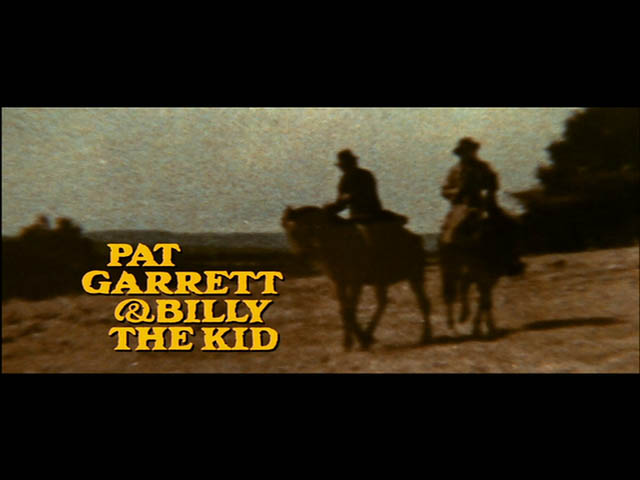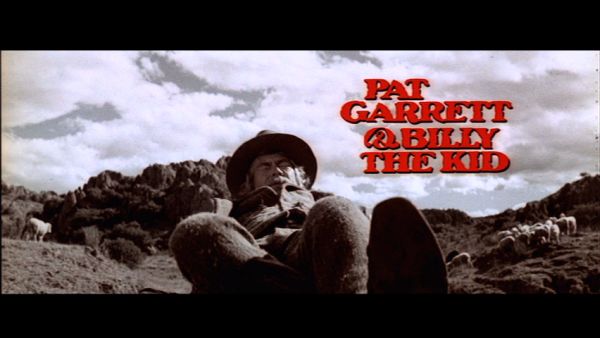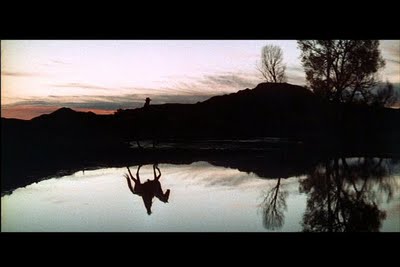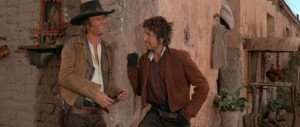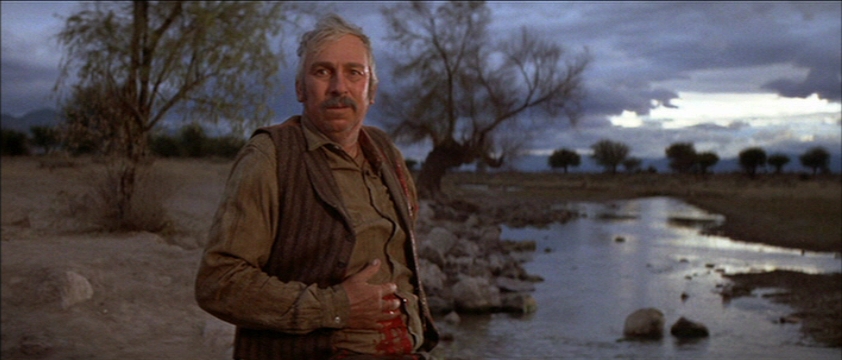From the Chicago Reader (March 16, 1990). — J.R.
PAT GARRETT AND BILLY THE KID
** (Worth seeing)
Directed by Sam Peckinpah
Written by Rudolph Wurlitzer
With James Coburn, Kris Kristofferson, Bob Dylan, Jason Robards, John Beck, Barry Sullivan, Slim Pickens, Katy Jurado, Jack Elam, Harry Dean Stanton, and Chill Wills.
Sometimes it’s hard to know if the film you’re seeing is the one its director intended you to see. Some recent foreign-language releases are cases in point. In fact, if there’s anyone left who takes the Academy Awards seriously — as an indication of a film’s quality rather than its capacity to turn coin — it’s worth pointing out that at least two of the foreign-language features nominated for Oscars aren’t being shown in their original forms in this country. The version of Camille Claudel showing here now is 21 minutes shorter than the original one shown in Europe. This apparently means that the edited-down version — presumably the one that Academy members were shown as well — is worthy of an Oscar while the complete version is not, and the same strictures seem to apply to Cinema Paradiso, opening this week, which has been reduced by about an hour from the two-part version originally shown in Italy, apparently on the assumption that American audiences are more fidgety than their European counterparts. Comparable readjustments were made last year with Pelle the Conqueror and The Little Thief, among other pictures, and as long as critics and audiences continue to put up with it, it is bound to happen more and more.
But U.S. distributors who think American spectators require spoon-feeding are only one reason films exist in multiple versions. Alternate versions of some important films exist because at one point or another someone decided the director’s cut wasn’t good enough. (What “good enough” means, of course, is highly variable, although it usually means what someone thinks is profitable.) Most often in these cases, original directors’ cuts are destroyed or lost. In the case of Orson Welles, a true director’s cut is often unobtainable because the films were taken out of Welles’s control before he finished — which is what happened, for instance, on The Magnificent Ambersons, Mr. Arkadin, and Touch of Evil — although, for a complex of reasons, there are still two versions available of both Mr. Arkadin and Touch of Evil, just as there are two versions of his Macbeth (both of them supervised by Welles), and several versions of The Trial (one representing his final cut, the others consisting of various hacked-up reductions made after the film’s copyright expired and it fell into the public domain).
Restoration work carried out in recent years on many of the surviving German films of F.W. Murnau and Fritz Lang, Erich von Stroheim’s Foolish Wives and Queen Kelly, Lewis Milestone’s All Quiet on the Western Front, George Cukor’s A Star Is Born, and David Lean’s Lawrence of Arabia has ensured that different versions of all these films now exist, although few, if any, of the longer versions are identical to the original releases. For rereleases of Playtime, Tom Jones, and Close Encounters of the Third Kind, the respective directors made alterations of various kinds — Jacques Tati restored a major scene to Playtime (although Tati’s original cut reportedly survives today only as an unprocessed negative), Tony Richardson cut some material from Tom Jones, and Steven Spielberg both cut from and restored material to Close Encounters. Terry Gilliam was obliged to make somewhat different versions of Brazil for the European and U.S. markets, and although David Lynch spoke a few years back about releasing his original cut of Dune on tape, this plan may have been sabotaged; a much longer version that wound up on TV was so far from his intentions that he had his name taken off it.
To polemically counter the notion of a “perfect” version of a film, Jean-Marie Straub and Daniele Huillet have put together four separate versions of two of their most recent films, The Death of Empedocles and its sequel Black Sin. The dialogue and camera placements in all four versions of each film are the same, but because the settings in which the films were made were subject to constant fluctuations in weather, what looks dark and overcast in one version might be bright and sunny in another, and the offscreen ambient sounds are similarly different. (Seeing or sampling different versions of both films at the Rotterdam film festival a few weeks ago — the only place and event that has been willing to show more than one version of each — gave me some bracing insights into how variable different experiences of “the same film” can be.)
In the case of Pat Garrett and Billy the Kid, there are more than just a couple of versions to speak about. First of all, there was Rudolph Wurlitzer’s script, originally written in the late 60s for producer Gordon Carroll and director Monte Hellman. Several drafts later, Hellman had been replaced by Peckinpah, who wound up betraying Wurlitzer’s script on so many different levels — although he brought Wurlitzer down to the Mexican locations in 1972-’73 to draft further rewrites during the shooting and wound up casting him in a bit part — that Wurlitzer couldn’t even bring himself to mention Peckinpah’s name in his introduction to the published version of his script, a 1973 Signet paperback. (About a decade later, Wurlitzer dealt with this traumatic experience more wryly in his novel Slow Fade.) But before Peckinpah could complete a final cut, the head of MGM, James T. Aubrey — affectionately nicknamed “the smiling cobra” within the film industry — who wanted to get the picture into theaters by Memorial Day of 1973, turned the footage over to other editors, giving them only two months to do their work. The film was released and flopped at the box office; Peckinpah tried unsuccessfully to bring a $2 million lawsuit against the studio, and six months later Aubrey resigned. Daniel Melnick, who remained as vice president in charge of production, supervised a re-editing of the picture by Peckinpah in 1974 for a possible rerelease.
Sixteen years later, this version is finally seeing the light of day; it’s showing at the Film Center this weekend. The same version can be seen on video with a third of the image cropped and the editing altered somewhat in order to preserve some rough continuity — the usual practice for transferring ‘Scope films to tape in the U.S., which is called “scanning,” and which to my mind is even worse than colorizing. The absurd and ironic consequence is that this latter “restoration” is also a partial amputation (or reamputation, because the original release version is on tape in a scanned version as well). On cable, by contrast — most recently, on the Movie Channel — Peckinpah’s cut can be seen in a “letterboxed” version that happily and uncharacteristically preserves the rectangular Panavision ‘Scope format by masking the upper and lower portions of the frame. But Peckinpah’s film as he intended it needs to be seen on a big screen, though I wasn’t able to preview it that way; I previewed it on both video and cable — which raises the very real question of whether I might think more of his version if I had seen it projected in a theater.
The production of this film was plagued with multiple disasters that included (a) the loss of crew members to another western being shot concurrently, also in Durango, Mexico, (b) an influenza epidemic (Peckinpah was one of its victims), (c) diverse technical snafus, including a new Panavision lens that developed focus problems, and (d) an attempt by the unit production manager to remove Peckinpah from the picture, which led to direct conflicts between Peckinpah and MGM; so it isn’t too surprising that the only version that seems all of a piece is the published version of Wurlitzer’s script.
Some films, of course, manage to triumph over comparable difficulties, but the incompatibility of several elements in this particular package seems to have made the going especially rough. The virtues and limitations of Peckinpah are those of a romantic obsessive, and only rarely in his work — such as in The Wild Bunch and in the underrated Bring Me the Head of Alfredo Garcia — did he have a situation that allowed him to follow his obsessions to their limits. Pat Garrett and Billy the Kid is much too episodic and sprawling in its structure to allow for this sort of concentration; Wurlitzer’s dialogue, the rambling plot, Bob Dylan’s songs and his first foray as a screen actor, the other performances, and the mise en scene all have their own isolated strengths, but only occasionally do they come together effectively. The studio’s original editing undoubtedly mucked things up still further, but even Peckinpah’s cut suffers at times from a sense that the elements are working at cross-purposes.
Wurlitzer’s original script about former outlaw Pat Garrett hunting down his old friend Billy the Kid is structured on the existential premise that Garrett and Billy don’t meet during the course of the film until their final confrontation in Fort Sumner in 1891, when Garrett kills Billy; the film covers the last three months of Billy’s life, after he escapes from the Lincoln County jail. Peckinpah demolished this premise at the outset by beginning the story proper with a reunion between Garrett (James Coburn) and Billy (Kris Kristofferson) in Fort Sumner before the latter’s arrest and escape; Peckinpah also added a prologue devoted to Garrett’s death 18 years later, which is intercut between the opening credits with Garrett’s arrival in Fort Sumner in 1891. (When he arrives, Billy and his companions are shooting the heads off live chickens buried in the ground, and Peckinpah structures his elaborate intercutting around the gunshots in the two scenes 18 years apart, using freeze-frames that shift from color to black and white.) The studio cut jettisons this complex, intercut prologue and simply begins with Garrett’s arrival in Fort Sumner during the chicken massacre.
Billy’s first arrest comes after an elaborate shoot-out in which Wurlitzer’s character, O’Folliard, is killed (in an interview years later Wurlitzer remarked ruefully “Perhaps I should have taken [Peckinpah’s] hint”). Taken to the Lincoln County courthouse and jail, Billy winds up playing poker with Garrett and another crony while his gallows are being built outside. Garrett’s deputy Bob Ollinger (R.G. Armstrong), a religious fanatic, stands guard with a shotgun while continually heaping abuse on Billy. A comparison of how this scene plays in the four available film versions — the Panavision studio cut, the scanned studio cut, the Panavision Peckinpah cut, and the scanned Peckinpah cut — gives some idea of the overall differences between these versions.
The functional bareness and simplicity of the jailhouse set — a spacious room rather than a cell — and Peckinpah’s compositional use of it are practically the only things the scene has going for it, and both of these elements are completely lost in the two scanned versions. Armstrong’s performance in this scene is terrible — overblown and unconvincing — and we know from Garner Simmons’s book Peckinpah: A Portrait in Montage that Peckinpah was perfectly aware of this problem. (As Armstrong recalls in an interview with Simmons, Peckinpah remarked to him during a rehearsal, “I don’t believe a goddamn thing you’re sayin’ or you’re doin’.” Armstrong implies that this bit of direction improved his performance by making him angry; maybe it did, but the performance is still unpersuasive.) Peckinpah’s version minimizes Armstrong’s lack of conviction by cutting away to other actors more often, and the full rectangular screen minimizes it even further by giving us much more in the frame to look at.
In all four versions, we can see the gallows being built outside through a window; the studio cut increases the sound of the hammering to make sure we notice it — something that doesn’t add much to the scanned version, where the window already takes up about half of the frame — while Peckinpah’s sound mix leaves it up to the viewer to notice, although the scanned version of his cut also undercuts this strategy. In both cuts, shortly before Billy makes his escape, we catch a glimpse of children playing on the newly built gallows while Ollinger watches them gleefully — a kind of passing detail that’s very characteristic of Peckinpah. The studio cut extends this moment, giving more attention to Ollinger’s reponse, and the scanned version of it literally shoves it in our faces. Peckinpah’s cut glides past the scene, yet the full-screen version of his cut still has much more impact and resonance, in part because of the ironic and decorous framing of an American flag on the left side of the gallows. The flag is completely missing in both of the scanned versions.
Bob Dylan, who appears in the film as Billy’s occasional sidekick Alias, composed and sang a few songs that serve as most of the movie’s score. The songs are reasonably effective once you get used to the anachronism; the main theme pivots around a few key refrains, such as “Billy, they don’t like you to be so free,” and “Billy, you’re so far away from home,” which serve to give some emotional shape to the wandering plot. Dylan as an actor, however, suffers from being too much himself — and too visibly aware of his own status as a pop icon — to come across as anyone else. Kristofferson, of course, is a singer as well, but his previous experience as a movie actor makes him more laid-back and comfortable here. The same more or less holds for James Coburn’s underplayed performance. (Kristofferson’s entire band at the time is cast in small parts, including his piano player Donnie Fritts — who appeared with Kristofferson again in Bring Me the Head of Alfredo Garcia — and his future wife Rita Coolidge.)
But the most memorable acting in the film comes from the extraordinary cast of secondary character actors — including Jason Robards, Barry Sullivan, Slim Pickens, Katy Jurado, Jack Elam, Harry Dean Stanton, Chill Wills, Elisha Cook Jr., and Gene Evans. Many of these actors appear only once, but Wurlitzer’s flavorsome dialogue and Peckinpah’s direction usually milk them for all they’re worth; in one especially touching scene, involving a minor character named Baker dying while his wife looks on, Slim Pickens achieves what is likely the apotheosis of his career, and Katy Jurado as the wife is almost equally moving.
For all his macho excess and bluster, Peckinpah at his best was an epic mural painter whose talents lay in coordinating small details within large canvases — talents that depended a great deal on a sense of balance both between and within his individual images. The belated release of his own cut of Pat Garrett and Billy the Kid allows us to see those talents fitfully, but the perverse butchering of that cut on the videotape version — the version that most Americans will likely wind up seeing — only adds further damage to the carnage already perpetrated by the 1973 studio cut. Check this movie out at the Film Center if you want to see what Peckinpah originally had in mind; settling for either of the two video versions is tantamount to spitting on his grave.

